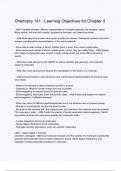Exam (elaborations)
Chemistry 141 - Learning Objectives for Chapter 4 Questions & 100% Verified Correct Answers with complete solutions (Latest update
- Course
- Chemistry 141
- Institution
- Chemistry 141
Chemistry 141 - Learning Objectives for Chapter 4 Questions & 100% Verified Correct Answers with complete solutions (Latest update
[Show more]



